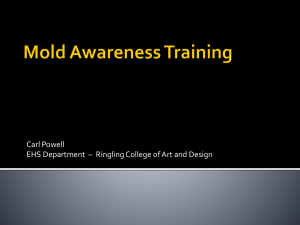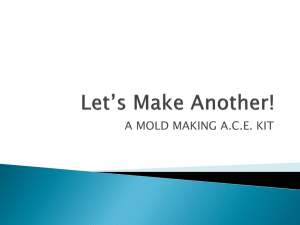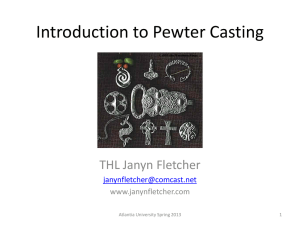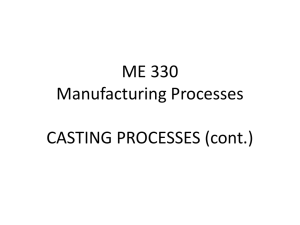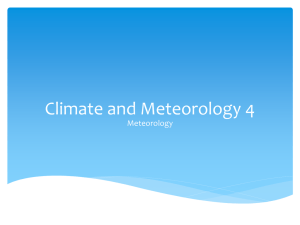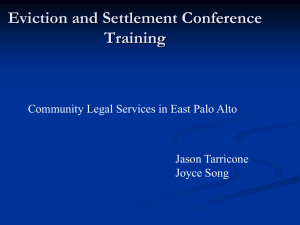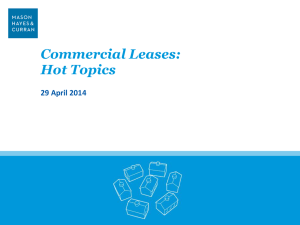Frankie Pendergraph PP Mold and Mildew Sept 2012
advertisement
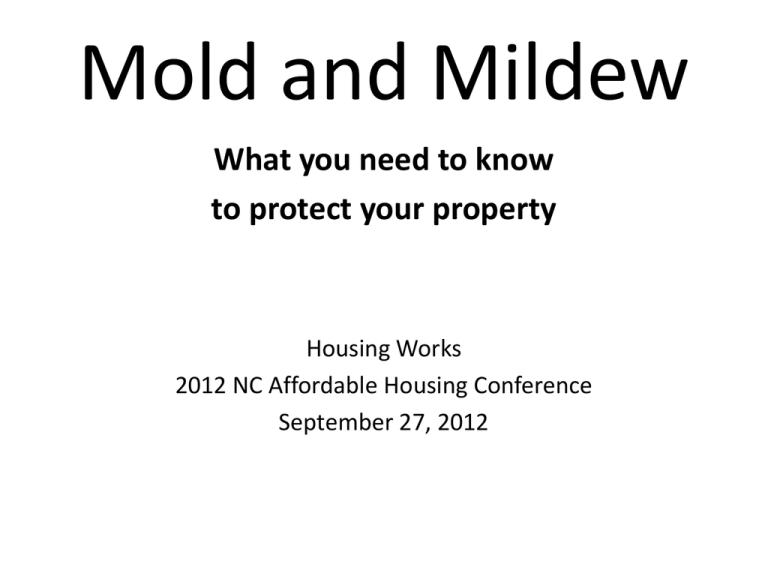
Mold and Mildew What you need to know to protect your property Housing Works 2012 NC Affordable Housing Conference September 27, 2012 Mold, the new four letter word Mildew vs Mold • Mold and Mildew are both types of fungi • Typically mold is black or green and more varied in color, and mildew is grey or white • Mold and mildew both spread from spores and both exist everywhere in nature • Mold typically grows on a food source and mildew typically grows on damp surfaces such as bathroom walls, leather and fabrics • Neither will grow without a high level of moisture • Mildew has a flat growth pattern, and mold has more of a fuzzy growth pattern Mildew vs Mold (cont) • Mildew many times left untreated can turn into mold if the food source and the water source are not addressed • Both can cause some possible allergic reactions in individuals that are susceptible to allergies • Both are preventable by keeping your home moisture free Mildew vs Mold (cont) • Many times people think that they have mold when they actually have mildew • Mildew is normally a precursor to mold • If you see a grey, ashy substance that you can brush with your hand, and the relative humidity in the unit is high, and there are no water leaks, chances are it is mildew. • Many times residents move furniture that has been stored or has gotten wet when moving and it only takes mildew or mold 24-48 hours to grow. Mildew on Leather Couch Mildew on Wood Table Mildew in Closet How does Mold grow? • Mold needs 5 basic ingredients in order to grow: 1. Food source 2. Air 3. Surface to grow on 4. Suitable temperature (between 40-100 degrees fahrenheit) 5. Moisture • If any of these ingredients are removed, the growth will stop; however, the easiest one to control is moisture Food Sources • Any substance that contains carbon atoms (organic substance) will provide sufficient nutrients to support mold growth • Even the oil from your skin when transferred to an unsuitable surface is enough to support the growth of some molds • Trying to eliminate the food source is virtually impossible • However, trying to keep things clean will make mold less likely to grow Air • We know that mold spreads by spores and they are literally everywhere • It is impossible to eliminate the spores • We all need air to live, so we cannot eliminate the air itself • However, we can improve air flow that will help reduce the growth of mold and mildew Over-stuffed Closet Surface to grow on • It is impossible to eliminate the unlimited number of surfaces that mold can grow on. • Your best bet here is to keep the surfaces clean which will help reduce the spreading of the mold • It is also important to keep surfaces free of moisture, leaks etc… Suitable Temperature • Mold will grow in cold temperatures as evidenced by seeing that orange in your refrigerator that has mold on it, and will grow in hot temperatures. • It is impossible to set the temperature at a level at which mold will not grow • Mold likes the temperatures that we like Moisture • So you see that the easiest thing to control, of the five necessary items, is moisture • First, check for any leaks in plumbing, roofs, foundations, windows, building envelope, HVAC system etc… • Check for the relative humidity within the unit that is normally caused by tenant lifestyle • Identify how to reduce condensation and relative humidity within unit Dew Point • Dew point indicates the amount of moisture in the air • The higher the dew point, the higher the moisture content in the air at a given temperature • The dew point temperature is the temperature at which the air would have to cool in order to reach saturation (the point at which the air can hold no more water vapor) Condensation • When dew point temp = air temp, air is saturated • Dew point temp is never greater than air temp • As air cools, moisture is removed from the air through condensation • This results in the formation of tiny water droplets that you see as fog, frost, clouds or precipitation Window – Outside Condensation Relative Humidity • Relative humidity (RH) is when the air temperature and dew point temperature are very close. The air has a high relative humidity . Condensation has not yet started. • Ideal relative humidity for no mold growth is 50%. When RH rises above 50%, condensation is increasing and moisture is increasing making it a perfect condition for mold growth. Relative Humidity (cont) • • • • • • • Insulation Hot spots, cold spots Closets, exterior walls Slabs, construction material Furniture Leaks around electric plugs, cracks in walls Poor air circulation Window - Inside Cold Spots Door Leaks Construction Materials • It can take 2-4 years for the moisture to completely dry out of your concrete slab and your construction materials. This is called the “moisture of construction.” • Weather conditions during construction can have an impact on moisture levels • Installation of wet materials • Slope, drainage Indoor Sources of Moisture • People, Plants, Pets, Cooking and Bathing • The average person produces 2.6 pints of moisture per day just by breathing and perspiring • 5-7 plants release 1 pint per day • A shower releases 0.3 pints per minute (12 pints for a 10 minute shower by 4 people) • Cooking releases 5 pints per day for a family of 4 Water Leak Indoor Sources (cont) • Indoor line drying of clothes creates 4-6 pints per load The primary method of controlling growth of mold is to avoid high humidity and surface condensation and keeping the relative humidity below 50%. You can see this will be a challenge with the amount of moisture generated by our residents on a daily basis and our energy efficient construction. Education • It is important for everyone to know how mold grows and how their buildings are built. • Mold Addendums • Transfer from Construction to Management • Dehumidifiers, Air Conditioning • Management Identification of Mold Staff Education • Do not freak when someone cries “Mold”. Management should have a written mold procedure for staff to follow. • Write up the Work Order and address it immediately • Try to locate the water source and take pictures of the unit • Get air quality test if necessary and remove the mold. • If no water leak, need to explain to the tenant that the problem is the RH based on their living conditions. Explain to them how to correct and put everything in writing. Make sure you have a Mold Addendum to your lease. Explain to them that it is their responsibility to clean up the mold. You may have to start eviction procedures. Responsibility If mold is created due to a problem with the building or neglect by the landlord, then it is the landlord’s responsibility. If the mold is due to the tenant’s living conditions or the tenant’s neglect, it is the tenant’s responsibility. It is the tenant’s responsibility to immediately notify the landlord of the existence of mold or any other problem within the unit. Mold Addendums • I would highly recommend that you use one • You can find various examples online • Make sure it does not conflict with your lease or regulatory agency • I would recommend getting it signed every year • I would recommend your leasing agent going over it in detail with the tenant Why do we have the problem now? • • • • • • • • New Building Standards Reduced breathability of buildings Soil conditions “Energy Efficiency” Air Conditioning More pollution, toxins More frequent litigation Information more easily accessible Insurance • Most commercial policies do not cover mold • Different treatment for mold caused by building problems versus tenant problems • Tenants should have renters insurance to cover their personal property. Commercial policies do not cover tenant’s personal property Litigation If the landlord responds to the tenant complaint, corrects any problem related to the building, documents everything in writing and with pictures, then ultimately the landlord will be okay. If the problem is caused by the tenant and the tenant’s living conditions you must document, explain to the tenant what is causing the problem. It is always good to have the mold addendum. Do not be afraid to evict. Even after you do all of this, it does not mean that you will not incur legal fees and expenses to defend a tenant lawsuit. Other things to prevent mold • • • • • • • • Keep the premises clean, regularly dust and vacuum Use hood vent when cooking Don’t pile up dishes in the sink and counters Avoid excessive amounts of indoor plants Use exhaust fans when bathing and showering Use ceiling fans for air circulation Avoid air drying clothes Wipe down windows when condensation is seen and open windows to allow air pressure to equalize Other things to prevent mold • • • • • • • • • Open blinds and curtains to allow light in the premises Wipe up spills on floors and counters immediately Make sure shower curtain is inside the tub or shower Remove all garbage and do not leave exposed food laying around Check washer hoses for leaks Notify landlord of any leaks related to the sinks, air conditioning, roofs Notify landlord of missing grout or tile Notify landlord of musty odors Move furniture away from the walls for air circulation and do not cram closets full of stuff, leave door cracked Raise the window Hygrometer • A hygrometer is a device that measures the relative humidity within an area. • They can be purchased at Home Depot, Lowes, Radio Shack and various other places. • They are inexpensive. • A good tool for all sites to have. Hygrometers Cleanup • Wet carpet, if not dried within 48 hours, should be thrown away • Anything that has raw sewage spilled on it should be thrown away immediately • Install a dehumidifier • Throw away all moldy materials that cannot be cleaned • Do not paint or caulk moldy surfaces Cleanup (cont) • If the mold is in an area less than 10 square feet, then you should be able to handle it yourself. • May want to wear an N-95 Respirator available at hardware stores ($12 - $25) • Wear long gloves and goggles • If biocides are used, make sure area is ventilated. Never mix choline bleach with other cleaning solutions or detergents that contain ammonia because toxic fumes can be produced Cleanup (cont) • Clothing and linens – wash with strong detergent or dry-clean • Dishes – wash in dishwasher or hand wash with detergent in hot water • Leather items – wet-wipe with leather cleaner • Porous personal items – dry-wipe with an electrostatic cloth and HEPA vacuum • Non-Porous personal items – wet-wipe with a clean cloth, spritz with alcohol or disposable antibacterial wipes. Cleanup (cont) • Hard furniture items – wet-wipe with a clean cloth, spritz with alcohol or disposable antibacterial wipes • Soft furniture items – HEPA vacuum thoroughly, follow with a chem-dry treatment then HEPA vacuum again



